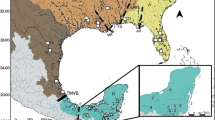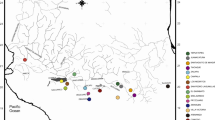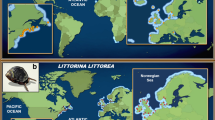Abstract
Inland aquatic organisms almost ubiquitously display a pattern of marked provincialism characterized by substantial population differentiation and genealogical discontinuities. This is the result of strong priority effects and local adaptation following dispersal and colonization of new habitats. We present a case that defies this biogeographic paradigm. We have investigated the phylogeography of the fairy shrimp Streptocephalus torvicornis across its circum-Mediterranean and Eurasian distribution. Based on three independent datasets, namely sequence variation at 12S and 16S rRNA, cyst morphology and male second antenna characters, we discern a pattern of extensive genetic and morphological homogeneity pointing to unhindered gene flow and widespread connectivity among populations. These intriguing findings may provisionally be explained by (i) a high dispersal frequency overwhelming the ability of a population to maintain resource monopolization, (ii) an outbreeding vigour opportunity offered to secondary immigrants, (iii) an ecological equivalence of genotypes generating long-term immigration–extinction equilibria and buffering genetic diversity over spatial scales, (iv) enhanced bird-mediated dispersal in open habitats as opposed to ponds surrounded by forests or shrub, or (v) a shallow population history with little time for substantial genetic differentiation.






Similar content being viewed by others
References
Aguilar, A., 2011. Weak phylogeographic structure in the endemic western North American fairy shrimp Branchinecta lynchi (Eng, Belk and Erickson 1990). Aquatic Sciences 73: 15–20.
Akaike, H., 1974. A new look at the statistical model identification. IEEE Transactions on Automatic Control 19: 716–723.
Alfonso, G., 2017. Diversity and distribution of large branchiopods (Branchiopoda: Anostraca, Notostraca, Spinicaudata) in Apulian ponds (SE Italy). The European Zoological Journal 84: 172–185.
Alonso, M., 1996. Crustacea, Branchiopoda. Fauna Iberica. Museo Nacional de Ciencias Naturales, Vol. 7. Consejo Superior de Investigaciones Cientificas, Madrid, Spain.
Audet, C., S. MacPhee & W. Keller, 2013. Constructed ponds colonized by crustacean zooplankton: local and regional influences. Journal of Limnology 72: 524–530.
Baeza, J. A. & M. S. Fuentes, 2013. Exploring phylogenetic informativeness and nuclear copies of mitochondrial DNA (numts) in three commonly used mitochondrial genes: mitochondrial phylogeny of peppermint, cleaner, and semi-terrestrial shrimps (Caridea: Lysmata, Exhippolysmata, and Merguia). Zoological Journal of the Linnean Society 168: 699–722.
Baxevanis, A. D. & T. J. Abatzopoulos, 2004. The phenotypic response of ME2 (M. Embolon, Greece) Artemia clone to salinity and temperature. Journal of Biological Research-Thessaloniki 1: 107–114.
Baxevanis, A. D., I. Kappas & T. J. Abatzopoulos, 2006. Molecular phylogenetics and asexuality in the brine shrimp Artemia. Molecular Phylogenetics and Evolution 40: 724–738.
Bruner, E., D. Costantini & G. Mura, 2013. Fractal analysis of the egg shell ornamentation in anostracans cysts: a quantitative approach to the morphological variations in Chirocephalus ruffoi. Hydrobiologia 705: 1–8.
Buhay, J. E., 2009. ‘‘COI-like’’ sequences are becoming problematic in molecular systematic and DNA barcoding studies. Journal of Crustacean Biology 29: 96–110.
Clarke, K. R. & R. N. Gorley, 2006. PRIMER v6: User Manual/Tutorial. PRIMER-E, Plymouth.
Daniels, S. R., M. Hamer & D. C. Rogers, 2004. Molecular evidence suggests an ancient radiation for the fairy shrimp genus Streptocephalus (Branchiopoda: Anostraca). Biological Journal of the Linnean Society 82: 313–327.
De Meester, L., A. Gómez, B. Okamura & K. Schwenk, 2002. The monopolization hypothesis and the dispersal-gene flow paradox in aquatic organisms. Acta Oecologica 23: 121–135.
de Waard, J. R., V. Sacherova, M. E. A. Cristescu, E. Remigio, T. Crease & P. D. N. Hebert, 2006. Probing the relationships of the branchiopod crustaceans. Molecular Phylogenetics and Evolution 39: 491–502.
Drummond, A. J. & A. Rambaut, 2007. BEAST: Bayesian evolutionary analysis by sampling trees. BMC Evolutionary Biology 7: 214.
Dumont, H. J., C. De Walsche & J. Mertens, 1991. Distribution and morphological variation of Streptocephalus torvicornis (Waga, 1842) in Northern Africa. Hydrobiologia 212: 203–208.
Dumont, H. J., J. Mertens & A. M. Maeda-Martinez, 1995. Historical biogeography and morphological differentiation of Streptocephalus torvicornis (Waga) since the Würm III-glaciation. Hydrobiologia 298: 281–286.
Estoup, A., C. R. Largiadèr, E. Perrot & D. Chourrout, 1996. Rapid one-tube DNA extraction for reliable PCR detection of fish polymorphic markers and transgenes. Molecular Marine Biology and Biotechnology 5: 295–298.
Figuerola, J. & A. J. Green, 2002. Dispersal of aquatic organisms by waterbirds: a review of past research and priorities for future studies. Freshwater Biology 47: 483–494.
Finlay, B. J., 2002. Global dispersal of free-living microbial eukaryote species. Science 296: 1061–1063.
Gandolfi, A., V. Rossi & P. Zarattini, 2015. Re-evaluation of three related species of the genus Branchipus Schaeffer, 1766 (Branchiopoda: Anostraca) by morphological and genetic analyses. Journal of Crustacean Biology 35: 804–813.
Hairston Jr., N. G., S. P. Ellner, M. A. Geber, T. Yoshida & J. A. Fox, 2005. Rapid evolution and the convergence of ecological and evolutionary time. Ecology Letters 8: 1114–1127.
Hall, T. A., 1999. BioEdit: a user-friendly biological sequence alignment editor and analysis program for Windows 95/98/NT. Nucleic Acids Symposium Series 41: 95–98.
Incagnone, G., F. Marrone, R. Barone, L. Robba & L. Naselli-Flores, 2015. How do freshwater organisms cross the ‘‘dry ocean’’? A review on passive dispersal and colonization processes with a special focus on temporary ponds. Hydrobiologia 750: 103–123.
Jensen, J. L., A. J. Bohonak & S. T. Kelley, 2005. Isolation by distance, web service. BMC Genetics 6: 13.
Ketmaier, V., D. Pirollo, E. De Matthaeis, R. Tiedemann & G. Mura, 2008. Large-scale mitochondrial phylogeography in the halophilic fairy shrimp Phallocryptus spinosa (Milne-Edwards, 1840) (Branchiopoda: Anostraca). Aquatic Sciences 70: 65–76.
Ketmaier, V., F. Marrone, G. Alfonso, K. Paulus, A. Wiemann, R. Tiedemann & G. Mura, 2012. Mitochondrial DNA regionalism and historical demography in the extant populations of Chirocephalus kerkyrensis (Branchiopoda: Anostraca). PLoS ONE 7: e30082.
Korn, M., A. J. Green, M. Machado, J. García-de-Lomas, M. Cristo, L. Cancela da Fonseca, D. Frisch, J. L. Pérez-Bote & A. K. Hundsdoerfer, 2010. Phylogeny, molecular ecology and taxonomy of southern Iberian lineages of Triops mauritanicus (Crustacea: Notostraca). Organisms, Diversity & Evolution 10: 409–440.
Kumar, S., G. Stecher & K. Tamura, 2016. MEGA7: molecular evolutionary genetics analysis version 7.0 for bigger datasets. Molecular Biology and Evolution 33: 1870–1874.
Ladoukakis, E. D. & E. Zouros, 2017. Evolution and inheritance of animal mitochondrial DNA: rules and exceptions. Journal of Biological Research-Thessaloniki 24: 2.
Maeda-Martinez, A. M., D. Belk, H. Obregón-Barboza & H. J. Dumont, 1995a. Diagnosis and phylogeny of the New World Streptocephalidae (Branchiopoda: Anostraca). Hydrobiologia 298: 15–44.
Maeda-Martinez, A. M., D. Belk, H. Obregón-Barboza & H. J. Dumont, 1995b. A contribution to the systematics of the Streptocephalidae (Branchiopoda: Anostraca). Hydrobiologia 298: 203–232.
Maniatsi, S., I. Kappas, A. D. Baxevanis, T. Farmaki & T. J. Abatzopoulos, 2009. Sharp phylogeographic breaks and patterns of genealogical concordance in the brine shrimp Artemia franciscana. International Journal of Molecular Sciences 10: 5455–5470.
Maniatsi, S., A. D. Baxevanis, I. Kappas, P. Deligiannidis, A. Triantafyllidis, S. Papakostas, D. Bougiouklis & T. J. Abatzopoulos, 2011. Is polyploidy a persevering accident or an adaptive evolutionary pattern? The case of the brine shrimp Artemia. Molecular Phylogenetics and Evolution 58: 353–364.
Marrone, F., S. Lo Brutto, A. K. Hundsdoerfer & M. Arculeo, 2013. Overlooked cryptic endemism in copepods: systematics and natural history of the calanoid subgenus Occidodiaptomus Borutzky 1991 (Copepoda, Calanoida, Diaptomidae). Molecular Phylogenetics and Evolution 66: 190–202.
Marrone, F., M. Korn, F. Stoch, L. Naselli-Flores & S. Turki, 2016. Updated checklist and distribution of large branchiopods (Branchiopoda: Anostraca, Notostraca, Spinicaudata) in Tunisia. Biogeographia 31: 27–53.
Mura, G., 1992. Additional remarks on cyst morphometrics in anostracan and its significance. Part II: egg morphology. Crustaceana 63: 225–246.
Mura, G. & V. Cottarelli, 1998. On the occurrence of Streptocephalus torvicornis Waga 1842 (Crustacea, Anostraca) on a coastal island off Italy. Hydrobiologia 367: 15–19.
Mura, G. & G. Rossetti, 2010. Intraspecific morphological diversity of anostracan resting eggs: Chirocephalus ruffoi Cottarelli & Mura, 1984 as a study case. Journal of Biological Research-Thessaloniki 14: 137–150.
Ortells, R., J. Vanoverbeke, G. Louette & L. De Meester, 2014. Colonization of Daphnia magna in a newly created pond: founder effects and secondary immigrants. Hydrobiologia 723: 167–179.
Palumbi, S. R., 1996. Nucleic acids II: the polymerase chain reaction. In Hillis, D. M., C. Moritz & B. K. Mable (eds.), Molecular Systematics. Sinauer Associates, Sunderland: 205–247.
Pinceel, T., B. Vanschoenwinkel, A. Waterkeyn, M. P. M. Vanhove, A. Pinder, B. V. Timms & L. Brendonck, 2013a. Fairy shrimps in distress: a molecular taxonomic review of the diverse fairy shrimp genus Branchinella (Anostraca: Thamnocephalidae) in Australia in the light of ongoing environmental change. Hydrobiologia 700: 313–327.
Pinceel, T., L. Brendonck, M. H. D. Larmuseau, M. P. M. Vanhove, B. V. Timms & B. Vanschoenwinkel, 2013b. Environmental change as a driver of diversification in temporary aquatic habitats: does the genetic structure of extant fairy shrimp populations reflect historic aridification? Freshwater Biology 58: 1556–1572.
Posada, D., 2008. jModelTest: phylogenetic model averaging. Molecular Biology and Evolution 25: 1253–1256.
Provan, J. & K. D. Bennett, 2008. Phylogeographic insights into cryptic glacial refugia. Trends in Ecology & Evolution 23: 564–571.
Remigio, E. A. & P. D. N. Hebert, 2000. Affinities among anostracan (Crustacea: Branchiopoda) families inferred from phylogenetic analyses of multiple gene sequences. Molecular Phylogenetics and Evolution 17: 117–128.
Richter, S., J. Olesen & W. C. Wheeler, 2007. Phylogeny of Branchiopoda (Crustacea) based on a combined analysis of morphological data and six molecular loci. Cladistics 23: 301–336.
Rogers, D. C., 2015. A conceptual model for anostracan biogeography. Journal of Crustacean Biology 35: 686–699.
Schwentner, M., B. V. Timms & S. Richter, 2012. Flying with the birds? Recent large-area dispersal of four Australian Limnadopsis species (Crustacea: Branchiopoda: Spinicaudata). Ecology and Evolution 2: 1605–1626.
Simon, C., F. Frati, A. Beckenbach, B. Crespi, H. Liu & P. Flook, 1994. Evolution, weighting and phylogenetic utility of mitochondrial gene sequences and a compilation of conserved polymerase chain reaction primers. Annals of the Entomological Society of America 87: 651–701.
Thiéry, A., 1987. Les crustacés branchiopodes Anostraca, Notostraca & Conchostraca des milieux limniques temporaires (dayas) au Maroc. Thèse Dr. Sc. Univ. d’Aix- Marseille.
Thompson, J. D., T. J. Gibson, F. Plewniak, F. Jeanmougin & D. G. Higgins, 1997. The CLUSTAL_X windows interface: flexible strategies for multiple sequence alignment aided by quality analysis tools. Nucleic Acids Research 25: 4876–4882.
Thum, R. A. & R. G. Harrison, 2009. Deep genetic divergences among morphologically similar and parapatric Skistodiaptomus (Copepoda: Calanoida: Diaptomidae) challenge the hypothesis of Pleistocene speciation. Biological Journal of the Linnean Society 96: 150–165.
Vanschoenwinkel, B., S. Gielen, M. Seaman & L. Brendonck, 2008. Any way the wind blows – frequent wind dispersal drives species sorting in ephemeral aquatic communities. Oikos 117: 125–134.
Weekers, P. H. H., G. Murugan, J. Vanfleteren, D. Belk & H. J. Dumont, 2002. Phylogenetic analysis of anostracans (Branchiopoda: Anostraca) inferred from SSU rDNA sequences. Molecular Phylogenetics and Evolution 25: 535–544.
Wiens, J. J. & M. J. Donoghue, 2004. Historical biogeography, ecology and species richness. Trends in Ecology & Evolution 19: 639–644.
Williams, D. M., 2011. Historical biogeography, microbial endemism and the role of classification: everything is endemic. In Fontaneto, D. (ed.), Biogeography of Microscopic Organisms. Is Everything Small Everywhere? Cambridge University Press, Cambridge: 11–31.
Zofkova, M. & B. V. Timms, 2009. A conflict of morphological and genetic patterns in the Australian anostracan Branchinella longirostris. Hydrobiologia 635: 67–80.
Acknowledgements
This article is dedicated to the memory of Graziella Mura who initiated the Streptocephalus project, coordinated it passionately but regrettably did not manage to see it complete. She has been a real friend and a mentor for all of us and we will always remember her. We would like to thank Dani Boix (University of Girona), Massoud Seidgar (University of Teheran), Juan Garcia de Lomas (University of Cadiz), Brigita Petrov (University of Belgrade), László Demeter (Sapientia Hungarian University of Transylvania) and Stanislaw Malavin (Russian Academy of Sciences, Saint Petersburg) for kindly providing samples.
Author information
Authors and Affiliations
Corresponding author
Additional information
Guest editors: Federico Marrone, D. Christopher Rogers, Paola Zarattini & Luigi Naselli-Flores / New Challenges in Anostracan Research: a Tribute to Graziella Mura
Graziella Mura—Deceased March 23 2016.
Electronic supplementary material
Below is the link to the electronic supplementary material.
10750_2017_3203_MOESM1_ESM.pdf
Measurements of body length and 16 morphological characters of the male second antenna (biometry_S.torv_males.pdf) (PDF 37 kb)
Rights and permissions
About this article
Cite this article
Kappas, I., Mura, G., Synefiaridou, D. et al. Molecular and morphological data suggest weak phylogeographic structure in the fairy shrimp Streptocephalus torvicornis (Branchiopoda, Anostraca). Hydrobiologia 801, 21–32 (2017). https://doi.org/10.1007/s10750-017-3203-6
Received:
Revised:
Accepted:
Published:
Issue Date:
DOI: https://doi.org/10.1007/s10750-017-3203-6




